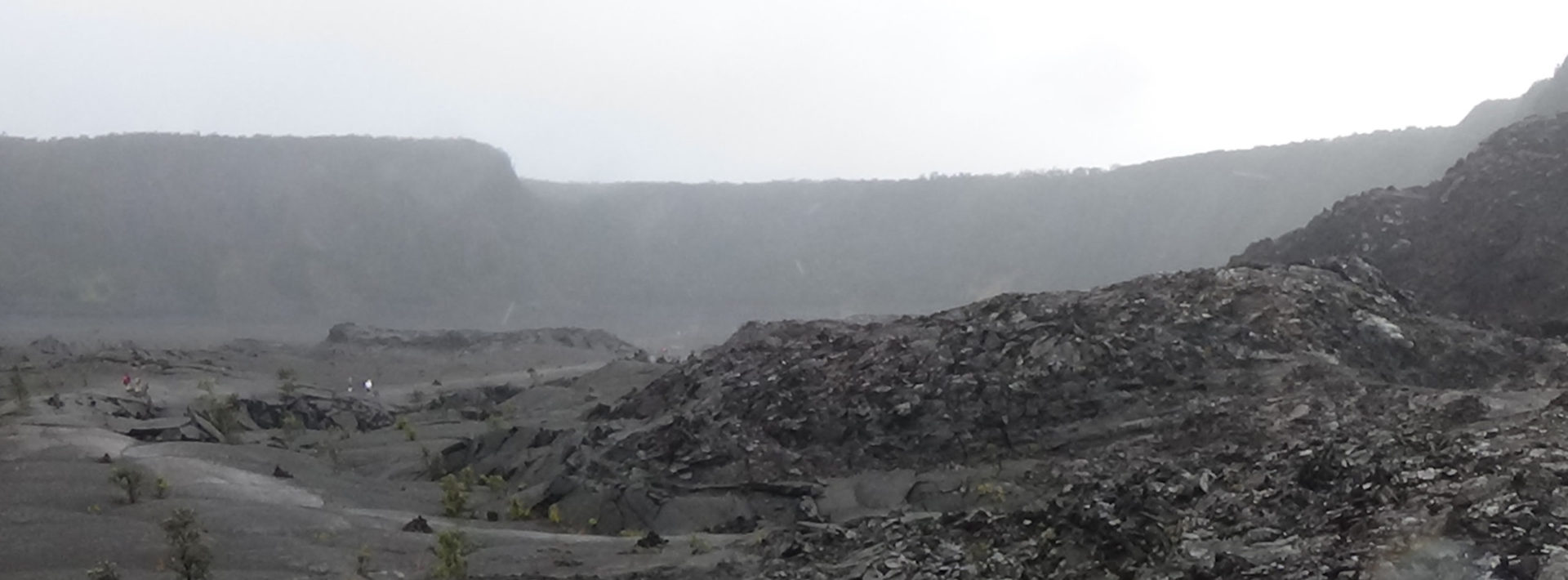TREX 2018 Day 3: Rocks! Lava! Steam! Fun!

By Meghan Reisenauer ’19

Kilauea’s craters seen from above
Day 3 in Hawai’i began with a hike to the Kilauea Iki crater. After stopping for photos at the lookout, where we could see both Halema’uma’u crater in the distance and the Iki crater, we headed down the trail. A trail sign told us we’d be descending and re-ascending 400 feet throughout the hike! The trail was so lush and green, we rarely caught glimpses past the leaves and into the crater until we emerged at the bottom of the mountain. Suddenly, we could see the vast lake of lava, now cooled about 67 years.

Kilauea Iki crater
The rock showed many different textures all over the surface, from fine sand, to sharp and porous a’a, to magenta bubbles and smooth rolling humps of cooled magma. It was a geologists’ dream! Although the basalt is a deep black, the crater was not without color. The outer layers of rock are constantly being weathered by wind and rain – and the rain here carries sulfur aerosols, which make it acidic. As the rock is exposed, it is oxidized by the air and reflects its chemical composition with a wide array of hues, from magenta to orange-red.

An ahu (stacked rock) showing its reddish iron oxides
There are more colors to see, too – calcium sulfate on the surface makes scatterings of white gypsum salt, and nitrogen-fixing algae and lichens also show in tiny white specks. Bigger organisms make their home on the lava rock, too – we saw many beautiful plants in all stages of growth, from tiny ferns to large flowering shrubs in bright shades of red and green.
We followed the ahu rocks to stay on the safe trail, worn smooth by many shoes on the brittle rock. the rock was slippery, so we had to step carefully – on this side of the island, it rains just about every day this time of year, and it certainly did not let up on us while we explored the crater. About halfway through the crater, we passed a large steam vent, in a rock pile about 50 feet above the surface. There were far too many types of rock to include here, but here are a few examples of an interesting rock formation:


After we had taken in the sweeping mountain views one more time, we headed back into the rainforest to make the steep climb back up. Before we left the site, though, we made sure to check out the Thurston lava tube – a huge natural cavern created by air in the flowing lava. It was eerily lit by orange lights, giving the tube an almost lava-like glow. Our group emerged from the darkness, muddy and damp, dreaming of our packed lunches. We ate ravenously on the drive back to camp and changed out of our wet clothes.

The lava tube
Next, it was finally time to break out the drone! We headed to a nearby coffee farm to take some footage of the fields. These pictures will allow us to compare red and near-infrared light reflecting off the plants, which we can use to calculate vegetation indexes and determine the health of the crop in each area of the field. The drone is outfitted with a normal RGB camera and an infrared cam, as well as a GPS system to keep it steady on a mapped course over the entire field.

The coffee mill
While we were at the Ka’u mill, some of us had to take advantage of the delicious coffee for sale and sampled the many flavors of macadamia nuts. Professor Kocar gave us a crash course on the drone and accompanying phone app, which are thankfully fairly intuitive to use. Tomorrow, we will present some of our research findings so far to local MIT alumni.
Testing out the drone
The night ended with a beautiful sunset over the Kilauea steam vents, only a five-minute walk from our camp. Stay tuned for more blogs from the TREX team with updates! 🙂

Kilauea Sunset
Every year, a group of MIT students and professors travel to the Big Island of Hawaii to gain fieldwork experience through TREX (Traveling Research Environmental EXperiences). The first TREX trip was held in 2000, and since launching has taken students on research activities in domestic and international settings. For more undergraduate opportunities, click here.



